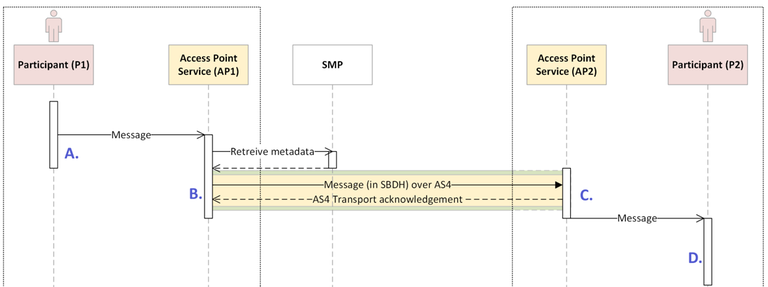- Startsida
- SFTI
- Peppol
- The Peppol transport model
- Use case
Use case
Below is a description of a typical use case for this transport model.
The use case can be illustrated clearly using the following sequence diagram.

Illustration of the sequence of activities
Message Transmission
This use case is called "Successful transmission of a message received and validated" and describes how a message is transported and acknowledged in Peppol's transport model.
Roles | Participant (P1 and P2), Access Point Service provider (AP1 and AP2) |
Assumptions | Receiving Participant (P2) is registered correctly in SMP. |
Flow A | Preparation, validation, enveloping, and initiation of transmission (Participant 1) 1. Participant (P1) intends to send a message to another Participant (P2). 2. P1 creates and validates the message based on the principles described in the current message specification. 3. P1 packages the message in an envelope according to the SBDH Enveloping Profile. The envelope includes, among other things, the identifier for the intended recipient (P2), collaboration process, and message type. 4. P1 hands over the message to its access point service provider (AP1). |
Flow B | Address lookup, transport enveloping, and message transmission (Access Point Operator 1) 5. AP1, based on the envelope's information, performs a lookup in SMP to retrieve necessary parameters to perform transmission according to the AS4 Transport Profile. 6. AP1 verifies that AP2's certificate, obtained from SMP, is issued to a Peppol-certified access point service provider. 7. AP1 uses AP2's public key obtained from SMP to encrypt the content of the AS4 payload. 8. AP1 establishes a secure TLS connection to AP2 and sends the message.
|
Flow C | Reception of the message, transport acknowledgment, and logging (Access Point Service provider 2) 9. AP2 receives the AS4 message and verifies that its signature is correct and that the certificate is issued to a Peppol-certified access point service provider. 10. AP2 returns (synchronously) a signed AS4 acknowledgment confirming the message has been received. 11. AP1 and AP2 log the event. 12. AP2 verifies that the envelope complies with what is required for the intended recipient and hands over the message to P2. |
Flow D | Reception of the message, validation, and creation of a message acknowledgment (Participant 2) 13. P2 validates that the payload of the message complies with its specifications. 14. Flow completed. |
Result | Message transferred from P1 to P2. |
Example | Transfer of an invoice |
